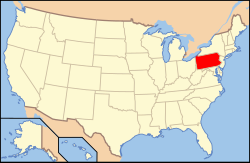Thornbury Township, Chester County, Pennsylvania
| Thornbury | |
|---|---|
| Township | |

The Squire Cheyney Farm, a historic site in the township
|
|
 Location in Chester County and the state of Pennsylvania. |
|
 Location of Pennsylvania in the United States |
|
| Location of Thornbury Township in Pennsylvania | |
| Coordinates: 39°55′50″N 75°32′43″W / 39.93056°N 75.54528°WCoordinates: 39°55′50″N 75°32′43″W / 39.93056°N 75.54528°W | |
| Country | United States |
| State | Pennsylvania |
| County | Chester |
| Area | |
| • Total | 3.9 sq mi (10 km2) |
| • Land | 3.9 sq mi (10 km2) |
| • Water | 0.0 sq mi (0 km2) |
| Elevation | 249 ft (76 m) |
| Population (2010) | |
| • Total | 3,017 |
| • Density | 770/sq mi (300/km2) |
| Time zone | EST (UTC-5) |
| • Summer (DST) | EDT (UTC-4) |
| Area code(s) | 610 |
| Website | http://www.thornburytwp.com |
Thornbury Township is a township in Chester County, Pennsylvania, United States. The population was 3,017 at the 2010 census. It is adjacent to, and was once joined with, Thornbury Township, Delaware County, Pennsylvania.
Thornbury Township was organized in 1687 with the appointment of Hugh Durborrow as constable and received its name from Thornbury, in Gloucestershire, England. At the time not more than five or six families lived within the limits of the township. George Peirce, one of the earliest and most influential inhabitants of the township, had a wife who was a native of Thornbury, in England, and the township was purportedly named to compliment her. Thornbury, Birmingham and Westtown townships are the only townships within the present limits of Chester County which were organized before 1704.
The township was divided when Delaware County was separated from Chester County in 1798. As a result, there is a Thornbury Township in each county. Landowners were allowed to choose which county they wished to be in, causing the line between the two townships, and the two counties, to be very irregular.
The Battle of Brandywine, part of the American Revolutionary War took place partially in the town. It was one of Thornbury's citizens, Squire Thomas Cheyney, who informed George Washington, commander of the Continental Army, of the approach of the British troops.
...
Wikipedia

